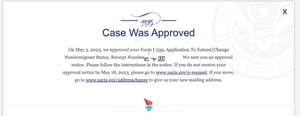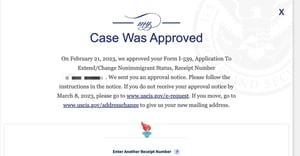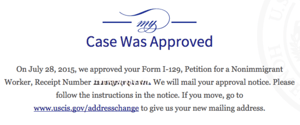What is an RFE?
An RFE, or Request for Evidence, is essentially a request from USCIS (U.S. Citizenship and Immigration Services) for additional documentation to support your application. Receiving an RFE doesn’t imply that your application will be denied or that it's more likely to be denied. Instead, it provides you with an opportunity to substantiate your application further.
For instance, if you're applying for an H1B visa, an RFE gives you a chance to strengthen your case by providing additional evidence that you meet the criteria for this type of visa, such as qualifications and the specialty nature of the job.
It’s crucial to respond to an RFE by the specified deadline, including all requested documents in a single response packet. Failure to respond on time or to provide all requested evidence typically results in USCIS making a decision with the existing information, which can often lead to a denial of the application.
H1B RFE Rate & Recent Trends
RFE Rates in Recent Years
The USCIS regularly updates and publishes data on immigration trends, including information about Requests for Evidence (RFEs).
RFE trends often vary with changes in the executive branch's administration. For example, the percentage of cases completed with an RFE was 21.4% in FY 2017. This rate increased to 38% in FY 2018 and further to 40.2% in FY 2019. It then decreased to 28.8% in FY 2020 and dropped further to 16.2% in FY 2021. After a minor decrease to 9.6% in FY 2022, the rate rose slightly to 10.5% in FY 2023.
Specifically for the latest data, FY 2023, the RFE rate for H-1B petitions was 10.5%, showing a slight increase from 9.6% in the previous year.
What are the Chances of H-1B Approval After an RFE?
USCIS also tracks the success rate of applications following an RFE. In FY 2023, the approval rate for cases that had received an RFE was 79.8%, a decrease from 85.5% in FY 2022. This data indicates the chances of obtaining an H-1B visa approval after responding to an RFE, highlighting the impact of thoroughly addressing the issues raised in the RFE.
H1B Denied Rates & Recent Trends
After the challenging period of the Trump administration, during which H1B visa denial rates soared to an unprecedented 24%, employers are now witnessing a significant turnaround with the average denial rate plummeting to only 2%, marking an all-time low, as revealed by recent studies. For full data, here is the official report.
Top 7 H1B RFE Reasons
This issue ranks among the top reasons for H-1B petition RFEs. It arises when the USCIS scrutinizes the complexity of the job role in question, doubting if it truly necessitates a bachelor's degree or higher in a specific area(s) pertinent to the responsibilities entailed. The USCIS frowns upon broad or ambiguous job summaries; certain roles, like "Computer Systems Analysts," follow varied educational trajectories, leading the agency to request further details about the job classification.
Successfully navigating a specialty occupation RFE hinges on demonstrating that the role demands specialized knowledge in a particular narrow field (or fields) of study, and that your academic achievements align with this requirement.
This is simple and clear-cut. To qualify for an H1B visa, the employee must meet the minimum wage requirement. Level 1 Wage is the entry-level wage rate for occupations under the H1B visa program, determined by the employee's experience, education, and level of supervision. It ranges from Level 1 for beginners to Level 4 for fully competent professionals. Even though level 1 is technically qualified for getting H1B, a specialty occupation might face scrutiny from USCIS if it qualifies only for a Level 1 wage. This is because an entry-level wage may contradict claims that the position is complex, specialized, or uniquely different from other roles in the same field. This is a common trigger for H1B Requests for Evidence (RFEs).
Positions eligible for an H1B visa require at least a bachelor's degree, with the degree being in a field relevant to the job. Applicants with degrees from foreign institutions might face a Request for Evidence (RFE) from H1B, asking for verification that their degree is equivalent to a U.S. bachelor's. Such verification necessitates official academic records.
An RFE might also arise if there's a perceived mismatch between the job role applied for and the applicant's field of study. In these instances, applicants need to articulate the connection between their academic background and the job they're seeking. Supportive letters or references from prior employers can be invaluable in demonstrating the applicant's suitability for the role.
Based on our observations, issues related to Maintenance of Status often involve the transition from an F1 Visa to an H1B Visa, especially for students participating in OPT or CPT. It is crucial to ensure that you have always worked legally, adhering to all work authorization requirements and only working during the authorized period. This is a significant concern for individuals who have used Day 1 CPT or are contemplating its use.
As noted on this page, H1B RFEs have a high approval rate, so there's no need to worry if you've used Day 1 CPT and received an RFE. However, to avoid any complications, you should:
- Adhere to all regulations during the transition from OPT to CPT
- Only pursue Day 1 CPT at an accredited university.
- Ensure that you maintain your F1 status diligently while utilizing CPT. This includes attending both on-site and online classes, completing your assignments, and upholding a GPA of 3.0.
- Never commence working before obtaining CPT I-20 work authorization.
The employer-employee relationship for H1B visa applications is assessed based on three key factors:
- Direct supervision of the H1B applicant by the employer.
- Location of supervision, whether on-site or off-site.
- The employer's control over the H1B employee's work.
Establishing a valid employer-employee relationship can be challenging when the work is performed off-site. Consequently, H1B applicants working off-site are more likely to receive a Request for Evidence (RFE) from USCIS.
The H-1B Labor Condition Application (LCA) plays a crucial role in your H1B petition. It is essential for your employer to include it in your petitions to avoid potential H1B RFEs from USCIS. The LCA is a requirement for USCIS to verify that all applicants meet the H1B criteria.
What Does a RFE Look Like?
When USCIS reviews applications for H1B, Green Cards and other immigration or non-immigration status, their officers follow detailed guidelines outlined in the USCIS Policy Manual. This manual includes charts and checklists that help determine when issuing a Request for Evidence (RFE) is necessary.
An RFE from USCIS is not crafted from scratch but is instead based on standardized templates that officers customize to address specific information or documentation gaps in an individual’s application.
Key Components of an RFE
- The Facts: An RFE typically begins with one or two introductory paragraphs about the original application. This section will mention the type of application, the date USCIS received it, and the office handling the processing. It usually states that there is insufficient evidence to decide on the application and that more is required.
-
The Law: This part of the RFE will cite relevant sections from the Immigration and Nationality Act (INA), the Code of Federal Regulations, and other pertinent laws. It details the eligibility requirements needed for the application.
-
Evidence Submitted: Lists all documents you have already provided. Review this section carefully to ensure all submitted documents are accounted for and to identify any discrepancies or omissions that could impact your application.
-
Evidence Lacking: Specifies what additional documents are needed to complete your application. This section often suggests alternative documents if the primary ones are unavailable. For instance, if a birth certificate is required but not available, school records and affidavits of birth may be accepted as substitutes.
-
Deadline: The final part of an RFE states the time frame within which you must submit the required documents. It also outlines the consequences of failing to respond within the given period, typically leading to a decision based on the information already on hand, which could result in application denial.
REF Samples
*After obtaining consent from students, we are sharing some RFE samples with future students. Both of the following students received RFEs because the schools they enrolled in before getting H1B were located too far from their legal residences.
*Read our guide on Why Location Matters When Choosing a Day 1 CPT program.


What Can You Do After Receiving H1B RFE
5 Steps to Take After Receiving an H1B RFE
Receiving a Request for Evidence (RFE) for your H1B application can be unsettling, but here are some practical steps to manage the process effectively:
Step 1: Thoroughly Read the RFE
Make sure you fully understand the content of the RFE. This will give you a clear idea of what additional information USCIS needs to proceed with your application.
Step 2: Understand your odds
An RFE is not an indication of a pending denial. It's simply a request for more information from USCIS to better understand your application. Avoid making hasty decisions in response. Reviewing the RFE rate and approval rate will show you that the chances of your H1B application being approved are actually quite high.
Step 3: Gather Comprehensive Documentation
Prepare all the documents that will substantiate your case. This may include expert opinion letters, job advertisements, and letters from vendors or clients that confirm the legitimacy and requirements of your position.
Step 4: Consult an Immigration Attorney
Consider seeking professional legal advice. An experienced immigration attorney can provide valuable insight into your specific case and assist in preparing the necessary documentation effectively. Their expertise can be crucial in ensuring you meet all requirements and avoid errors.
Step 5: Check Submission Details
Verify the submission address and the deadline for responding to the RFE. It's crucial that your response package is accurate and delivered on time to avoid unnecessary delays or complications.
By following these steps, you can respond to an H1B RFE with confidence and increase the likelihood of a successful outcome for your visa application.
Testimonials
The CPTDog team has a strong history of helping clients navigate H1B Request for Evidence (RFE) notices. We support them every step of the way, addressing any issues mentioned in the RFE, and ultimately securing their H1B approval notices.


-4.png?width=300&name=Untitled%20design%20(1)-4.png)

H1B RFE Free Consultation
CPTDog Offers:
✓ One-on-One Free Consultation with Visa Experts
✓ Connect You to Reliable Immigration Lawyers
✓ Transparent Service Fe
* Our consultants are committed to providing a seamless experience. Once you initiate a case with us, you will be assigned a specific consultant who will thoroughly understand your case, ensuring that there's no need for you to repeat information each time you call. We will not change your consultant unless you request it.
)%20(6).png?width=101&height=101&name=%E8%83%8C%E6%99%AF%20(Canvas%20(Square))%20(6).png)